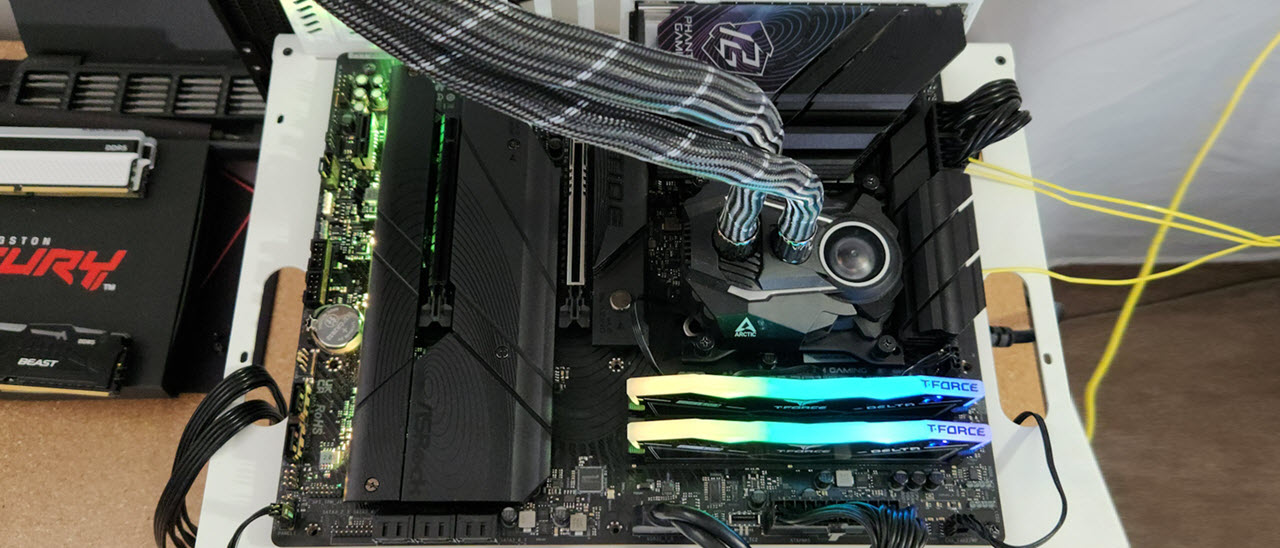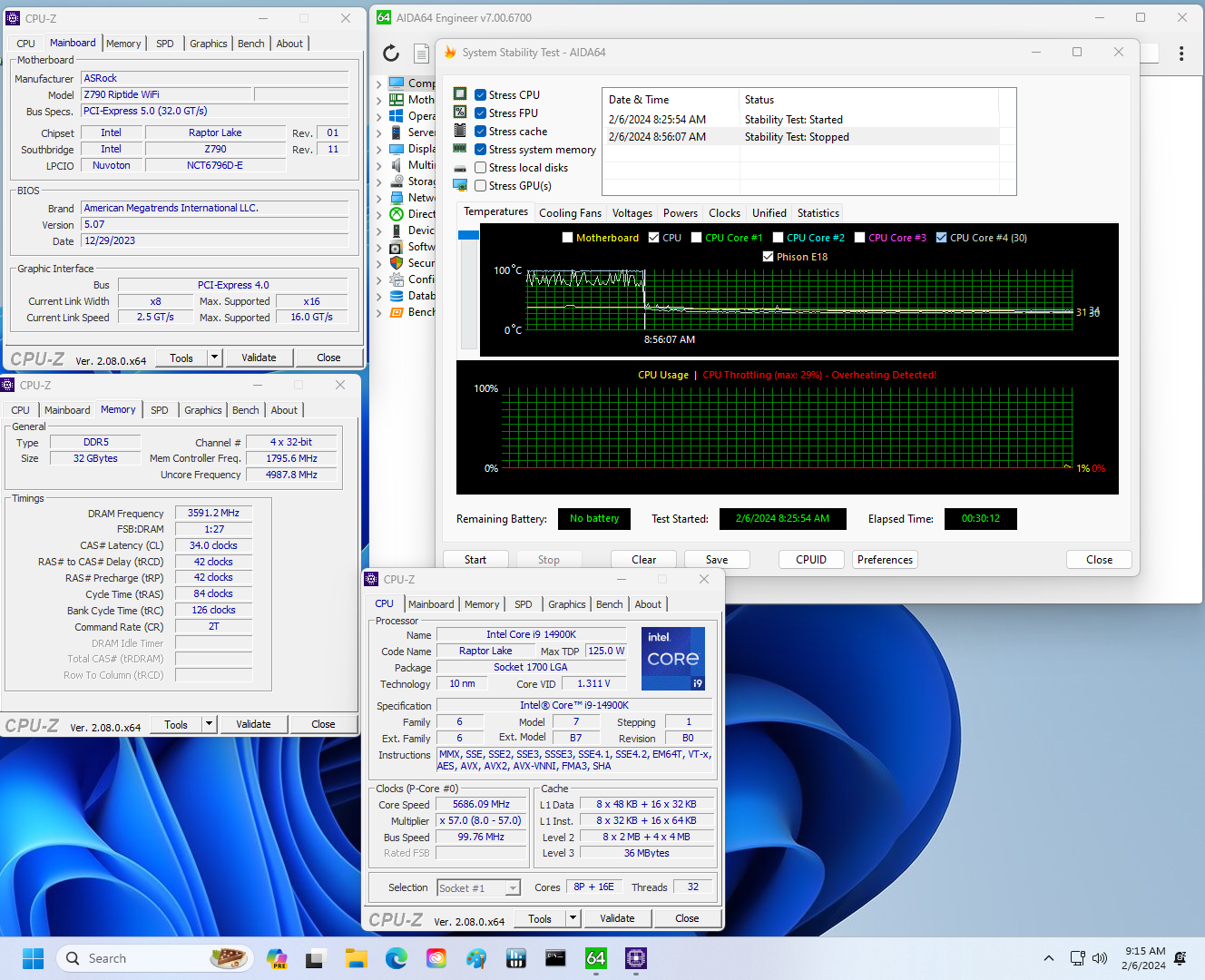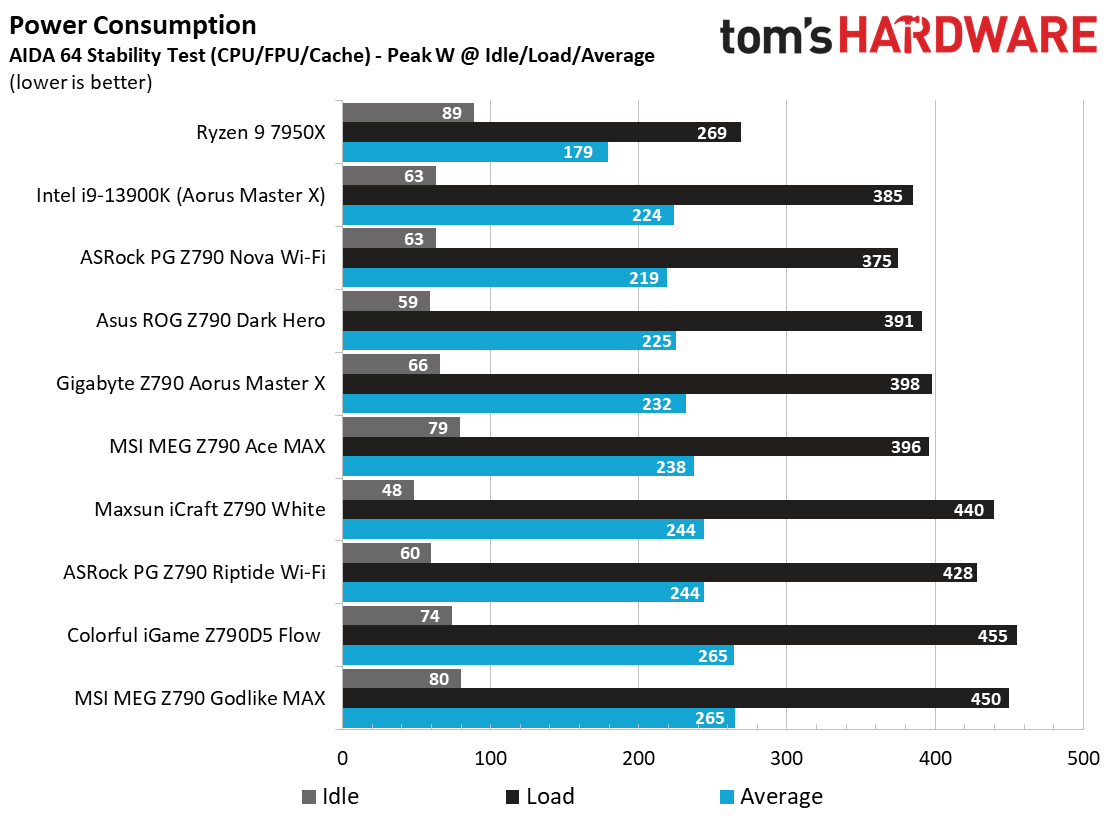Why you can trust Tom's Hardware
Our standard benchmarks and power tests are performed using the CPU’s stock frequencies (including any default boost/turbo) with all power-saving features enabled. We set optimized defaults in the BIOS and the memory by enabling the XMP profile. For this baseline testing, the Windows power scheme is set to Balanced (default) so the PC idles appropriately.
Synthetic Benchmarks
Synthetics provide a great way to determine how a board runs, as identical settings should produce similar performance results. Turbo boost wattage and advanced memory timings are places where motherboard makers can still optimize for stability or performance, though, and those settings can impact some testing.
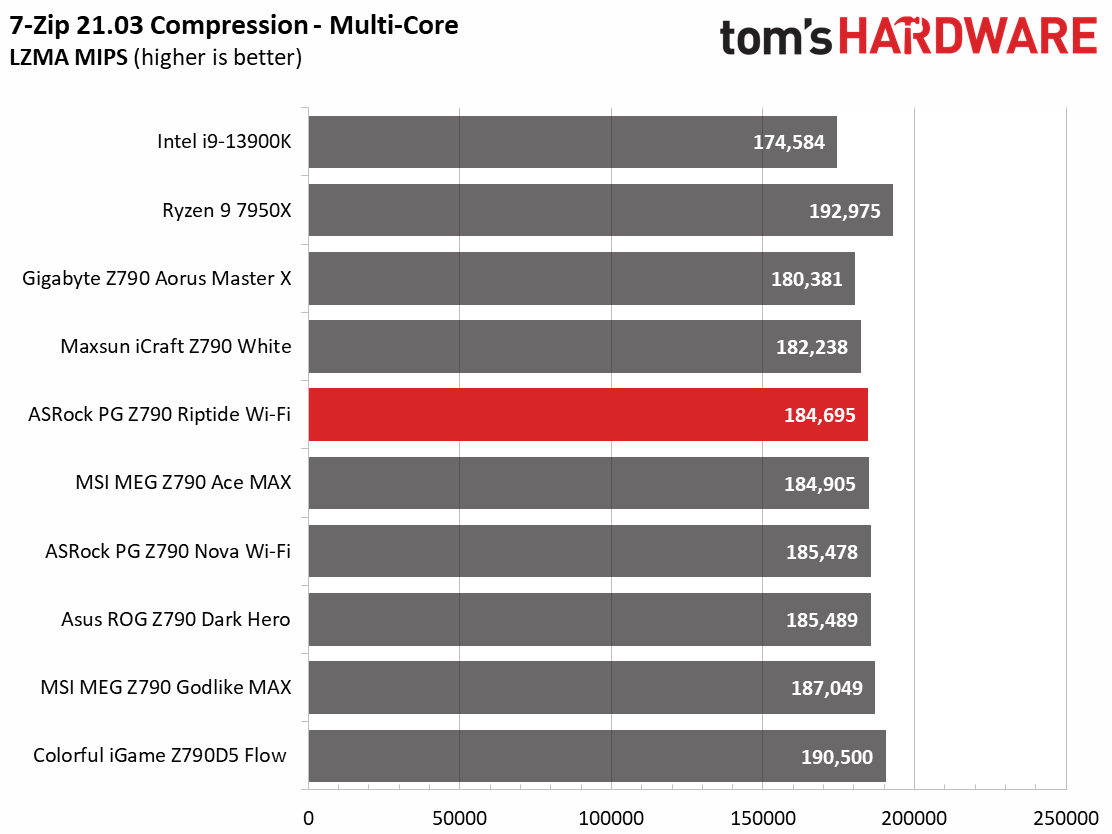
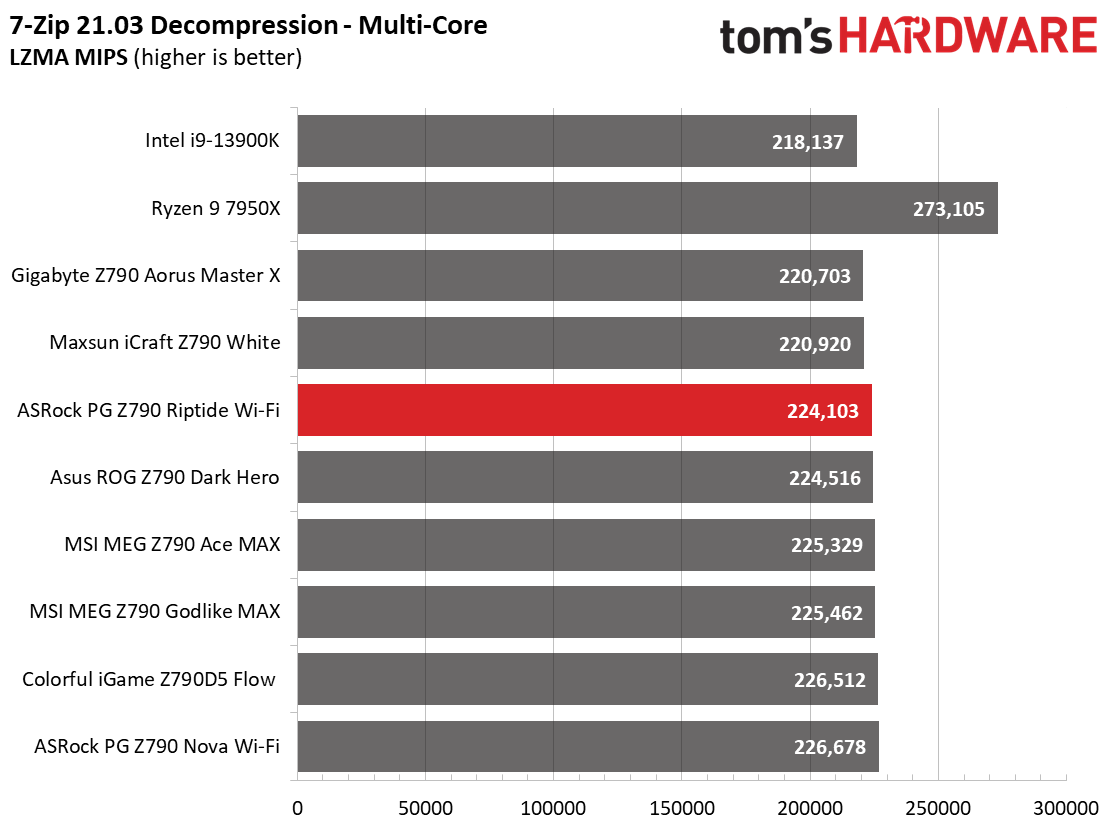
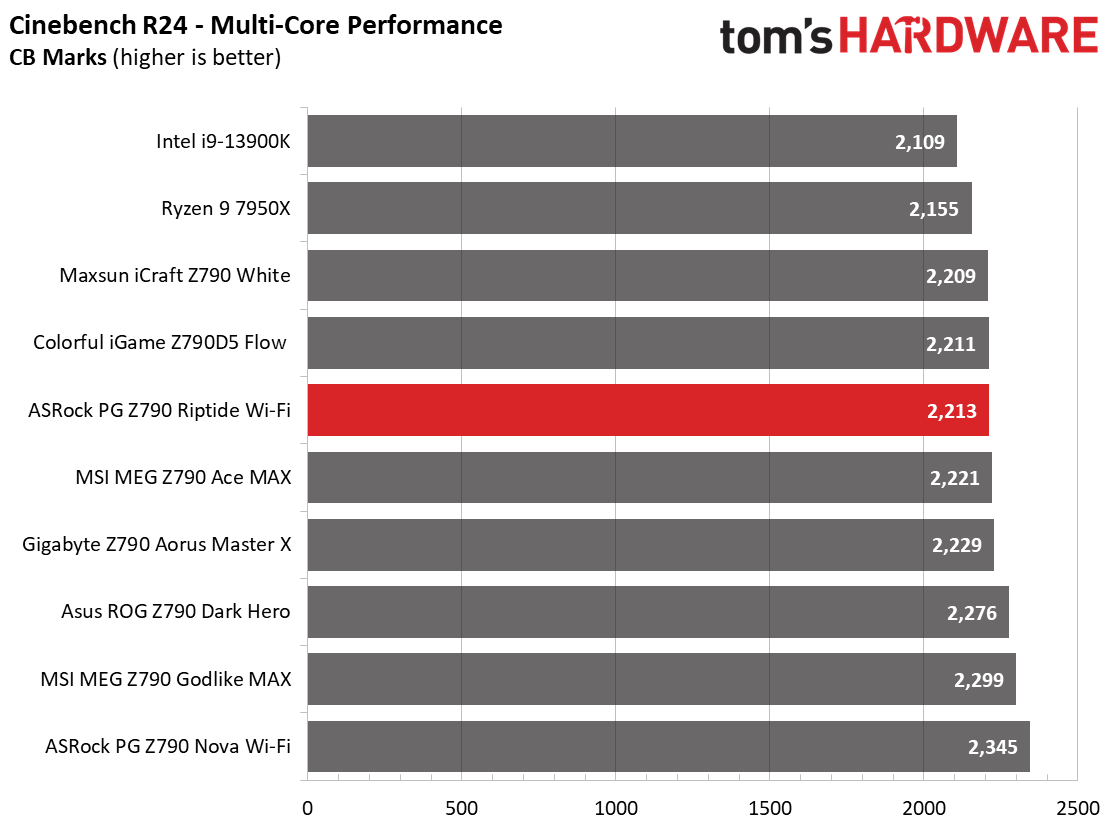
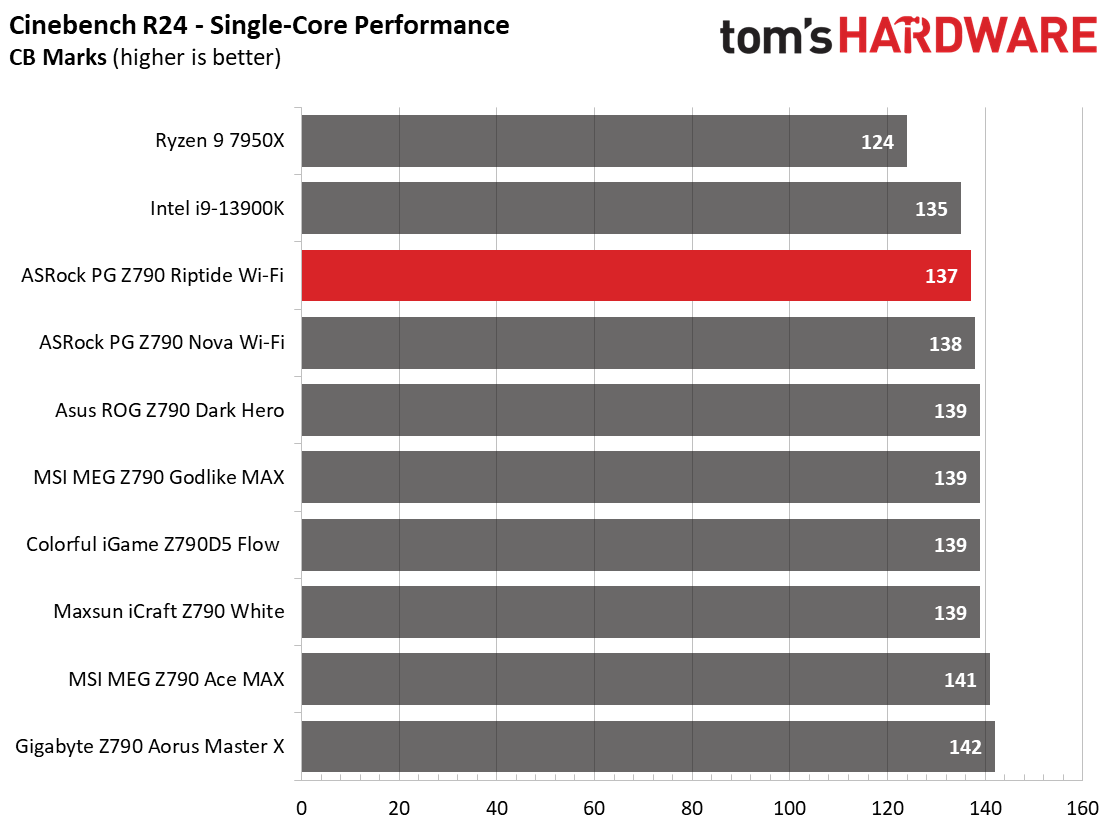
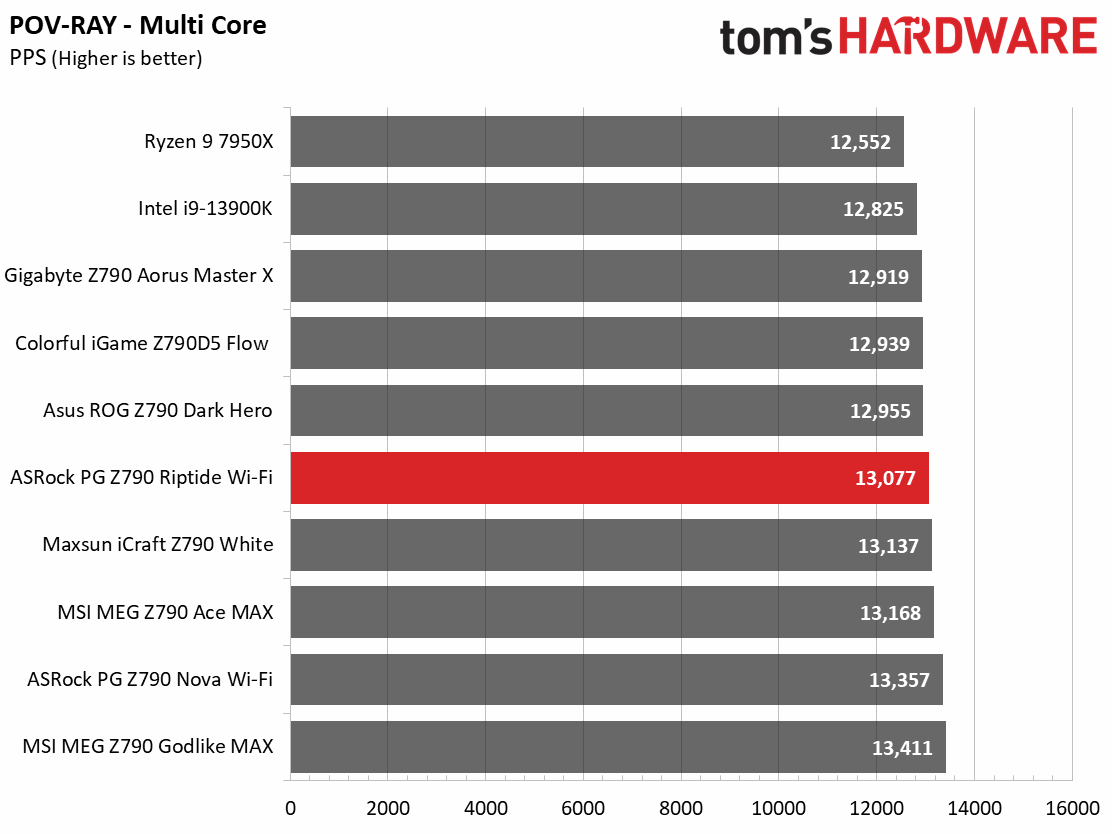
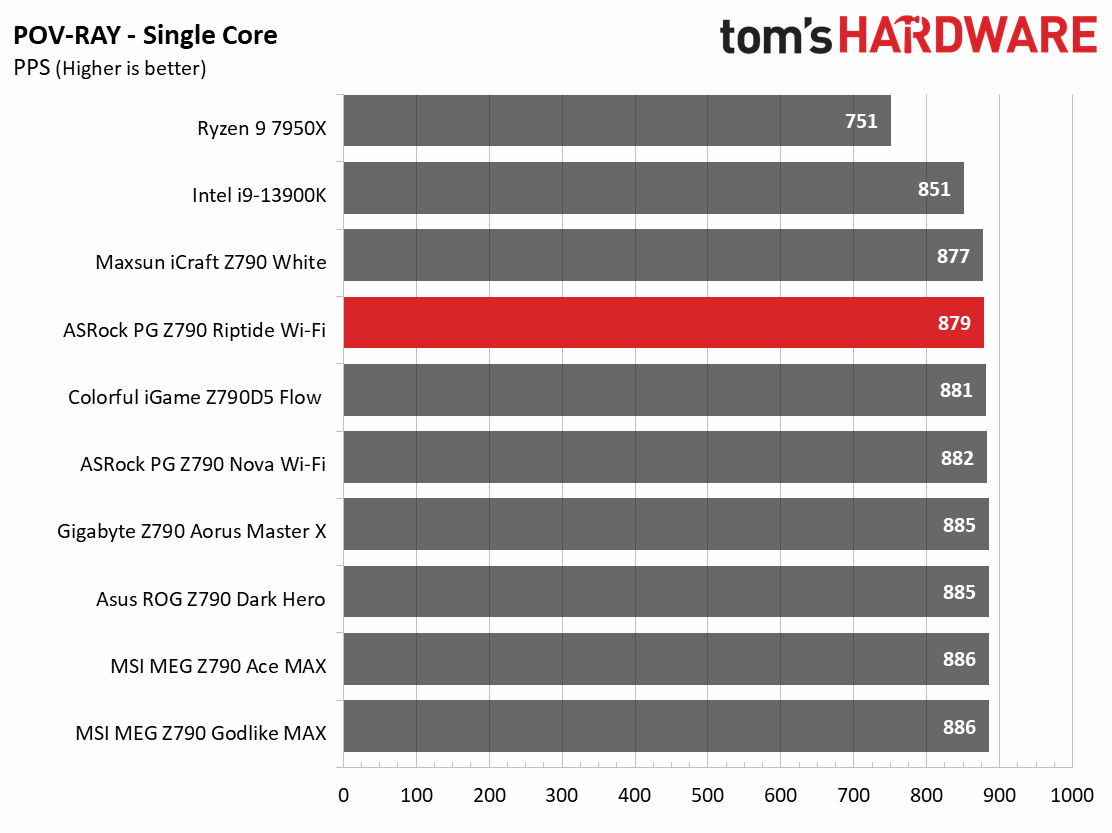
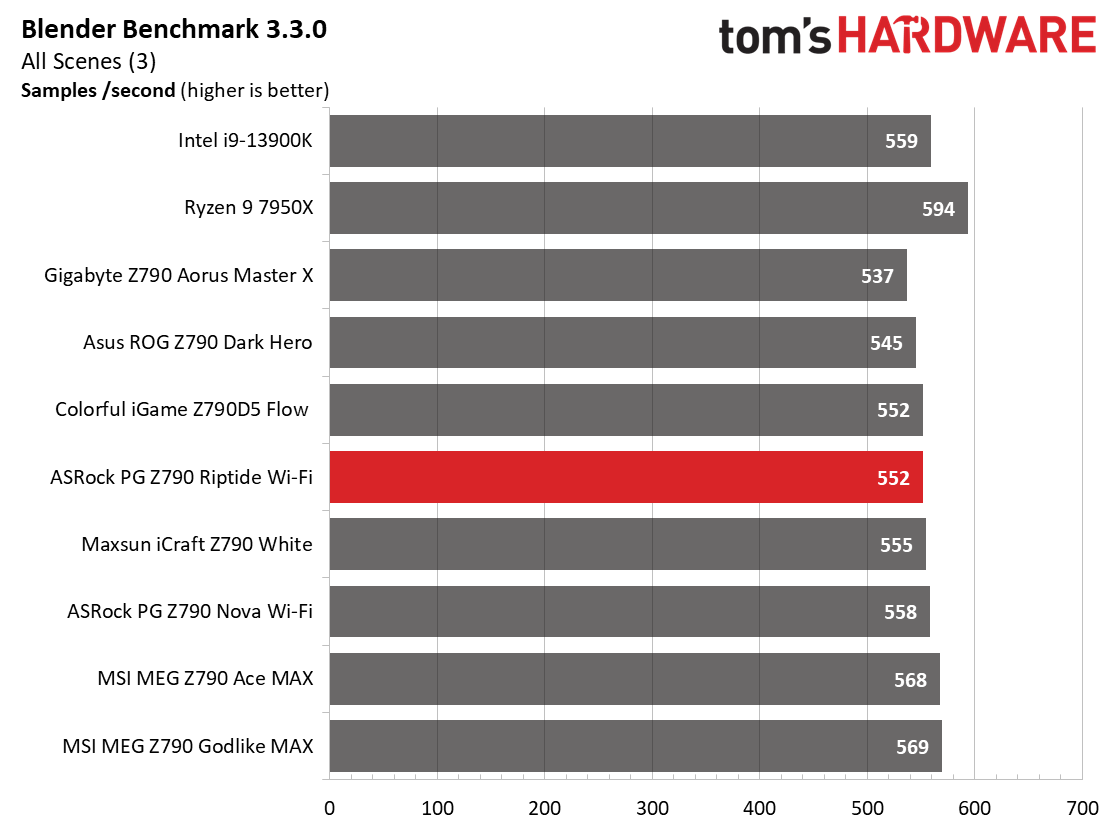
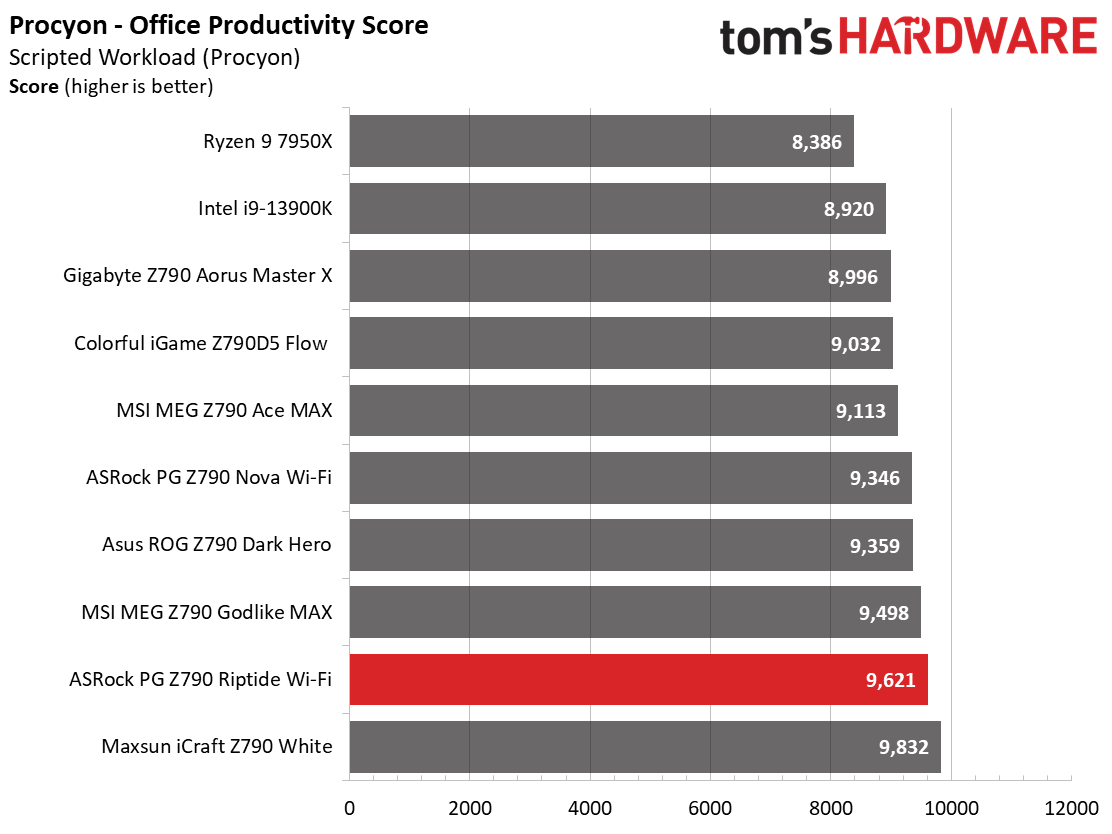
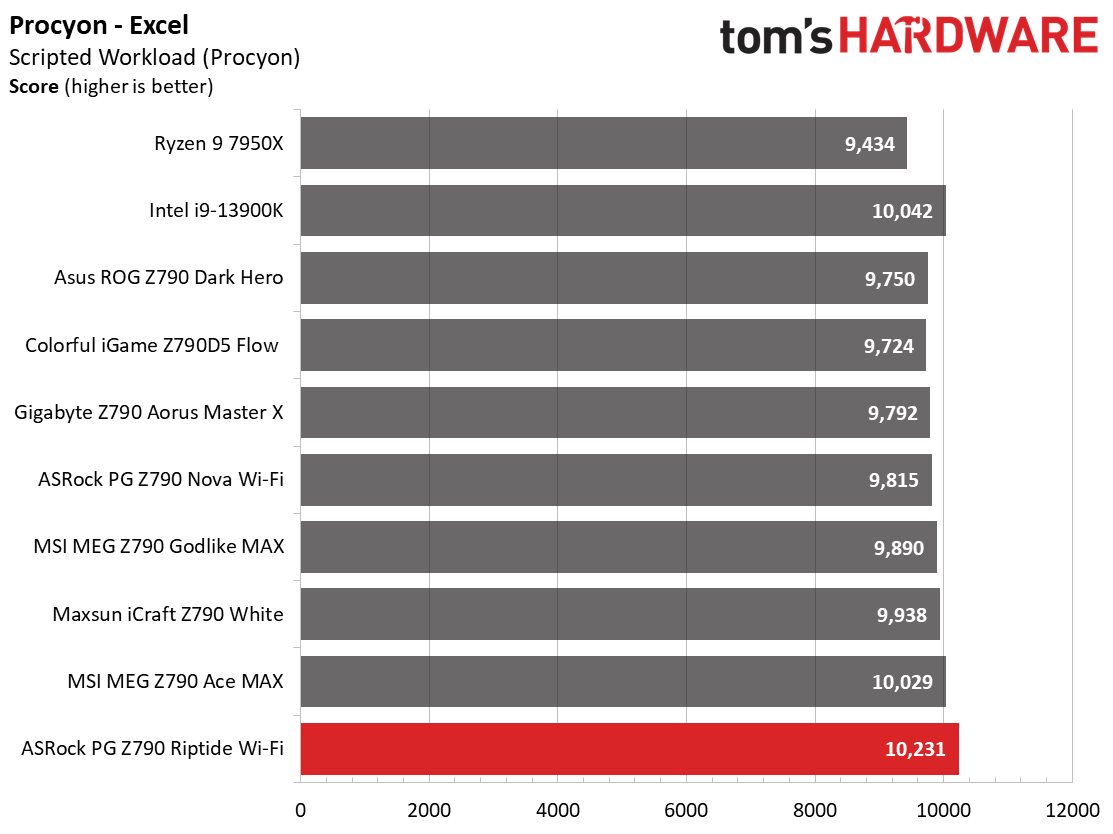
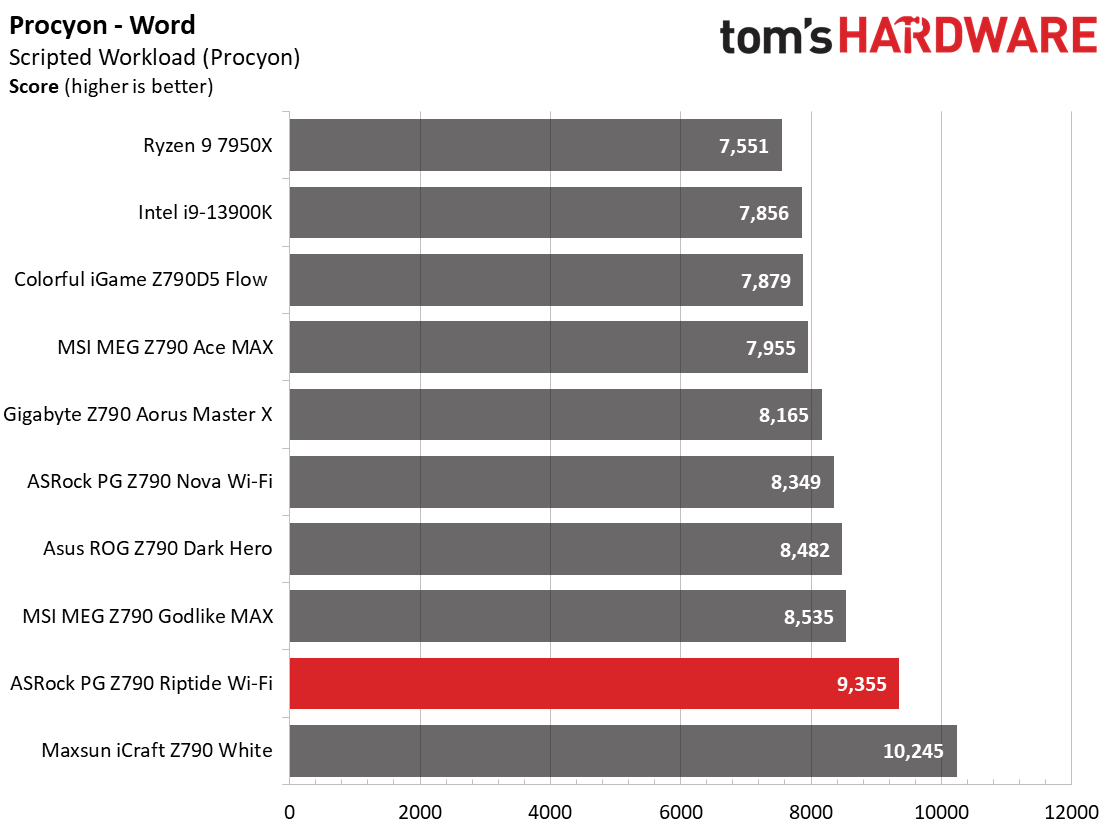
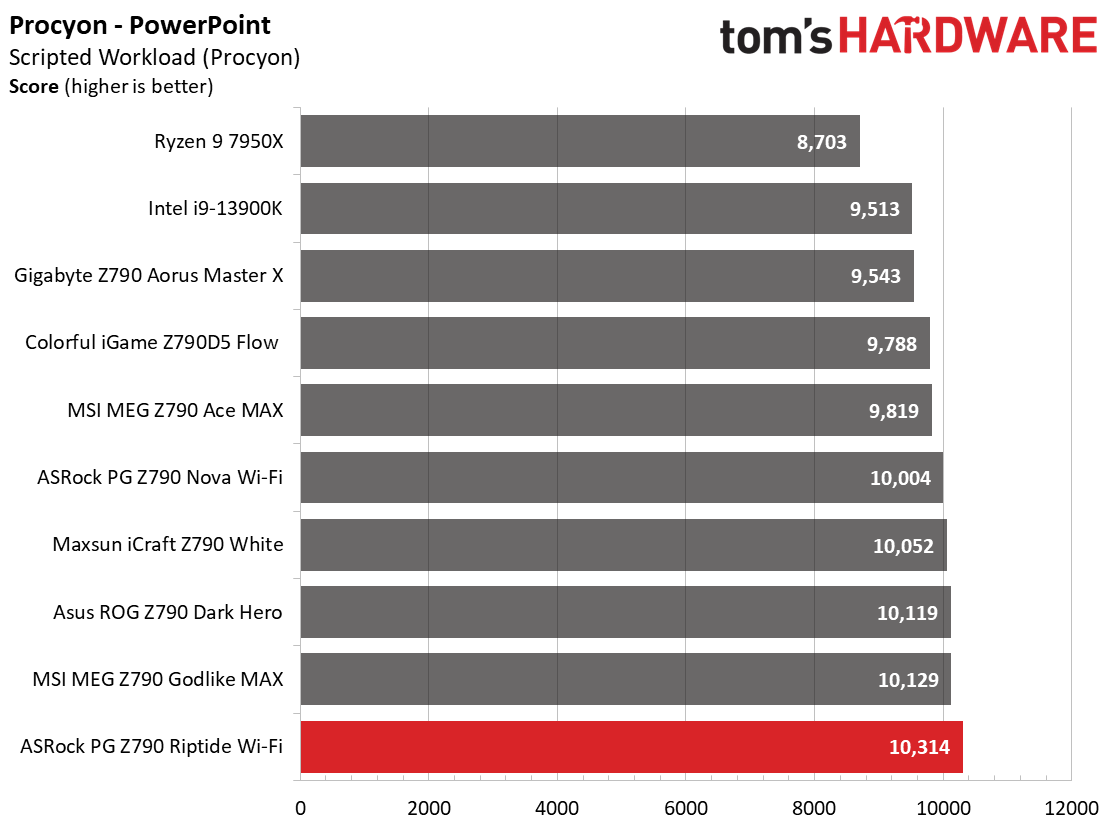
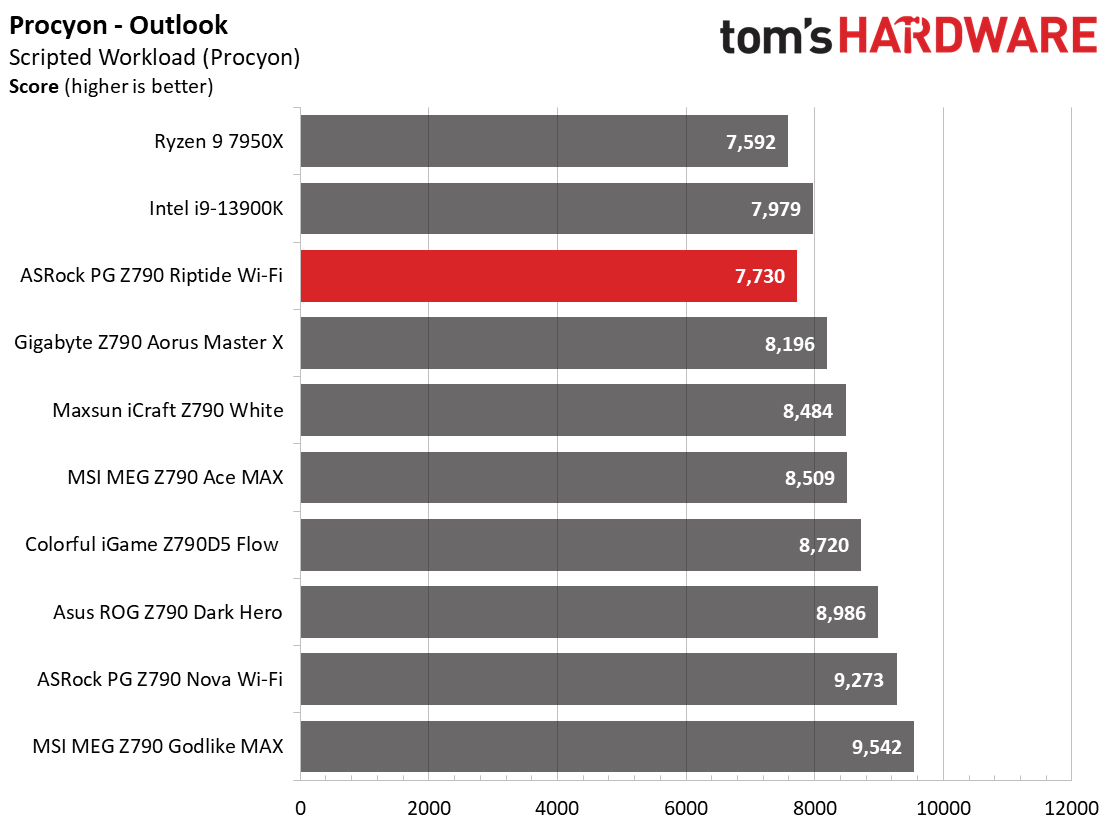
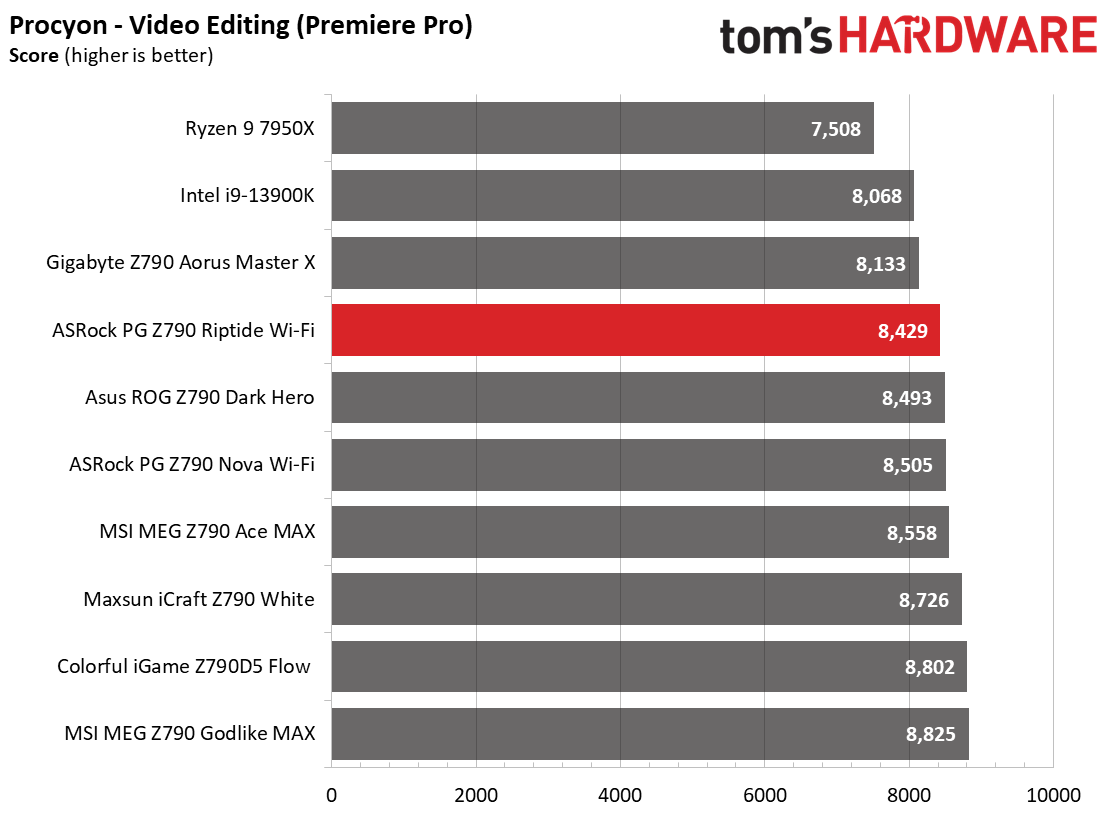

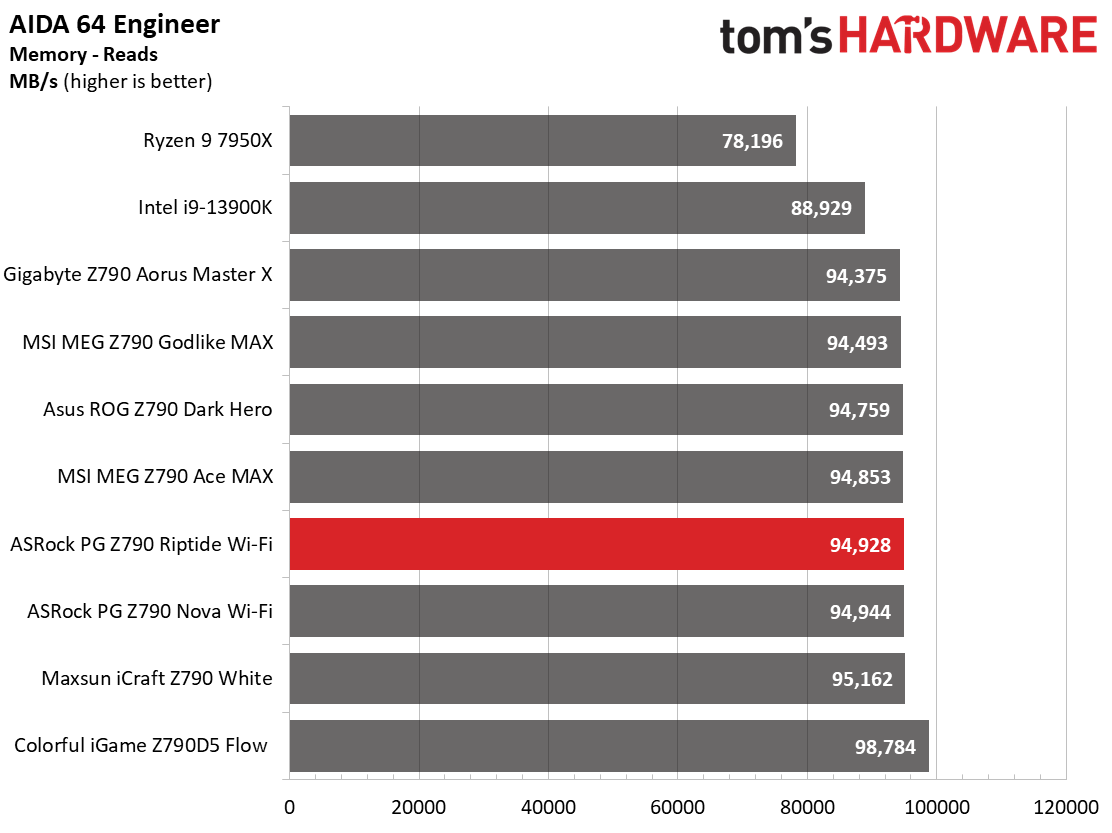
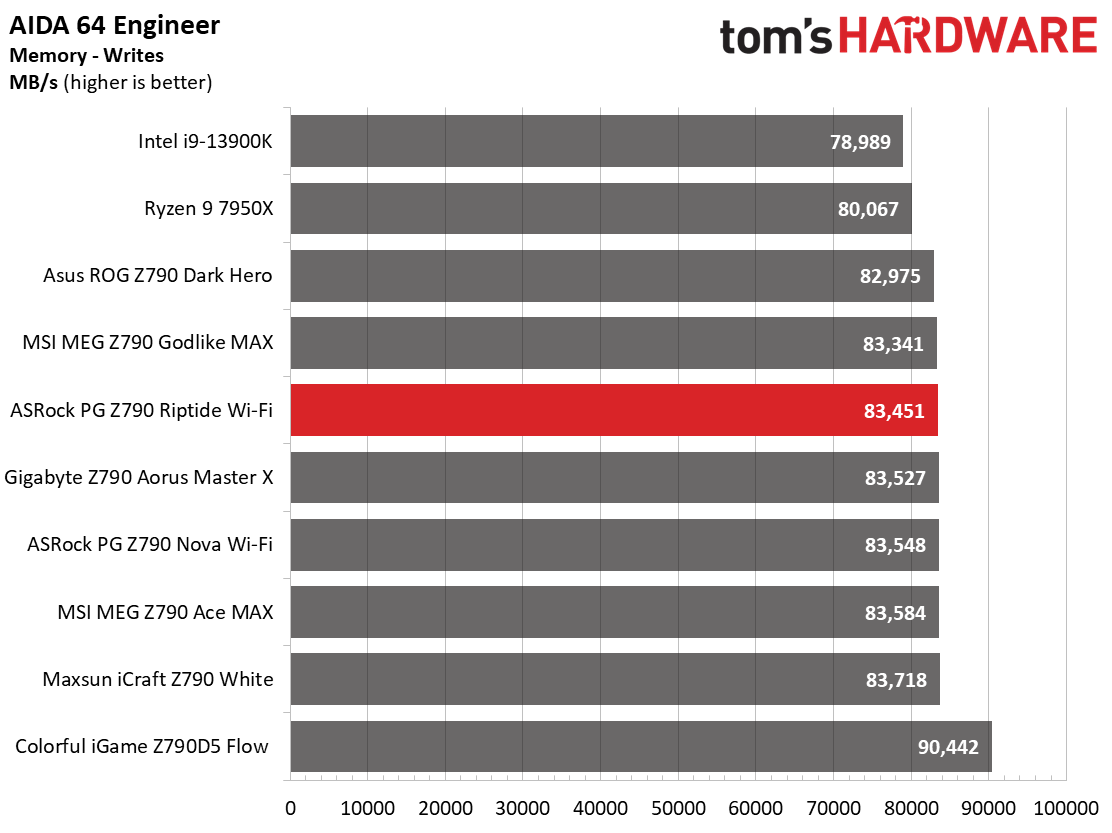
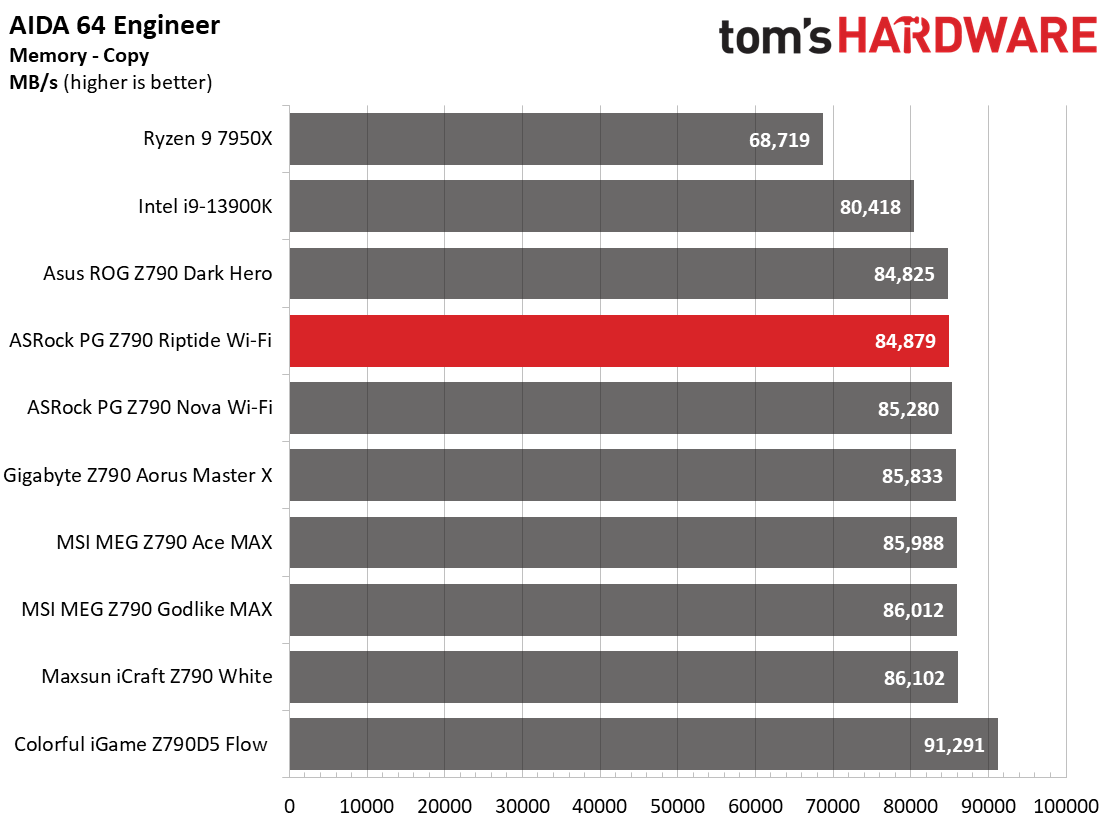
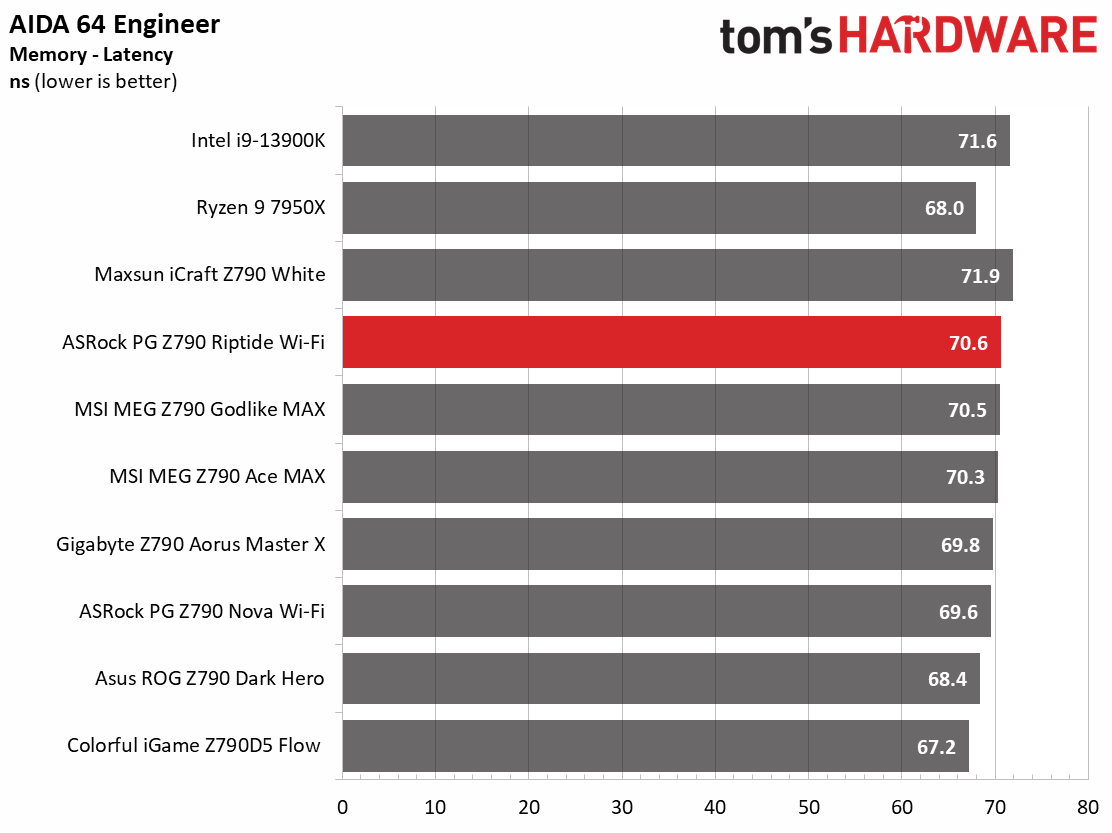
In most synthetic tests, performance in those benchmarks was around average to slightly below average. The Procyon Office test showed excellent results, some of the best we’ve seen across the swath of tests. With a PL2 limit of 320W using the 360//420mm AIO setting, you’re limited by cooling in any long-running heavily multi-threaded tests as you are with any motherboard with liberal PL settings above the Intel specification.
Timed Applications
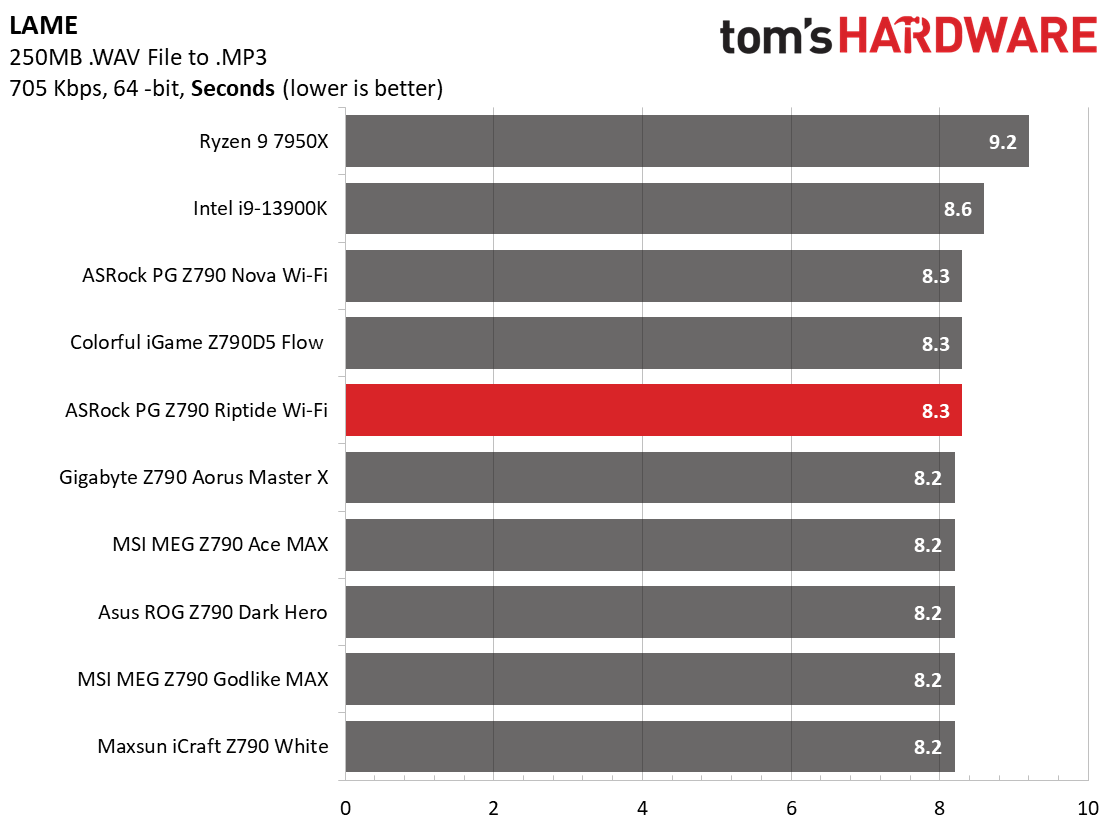
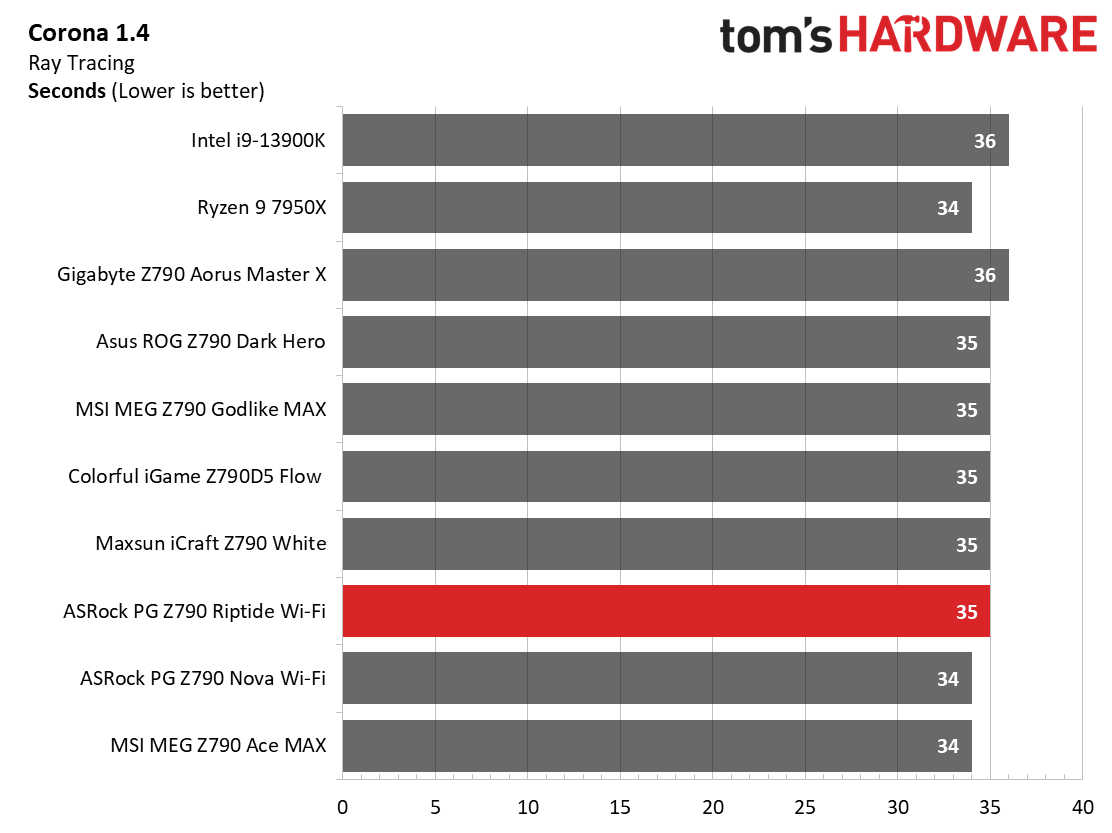
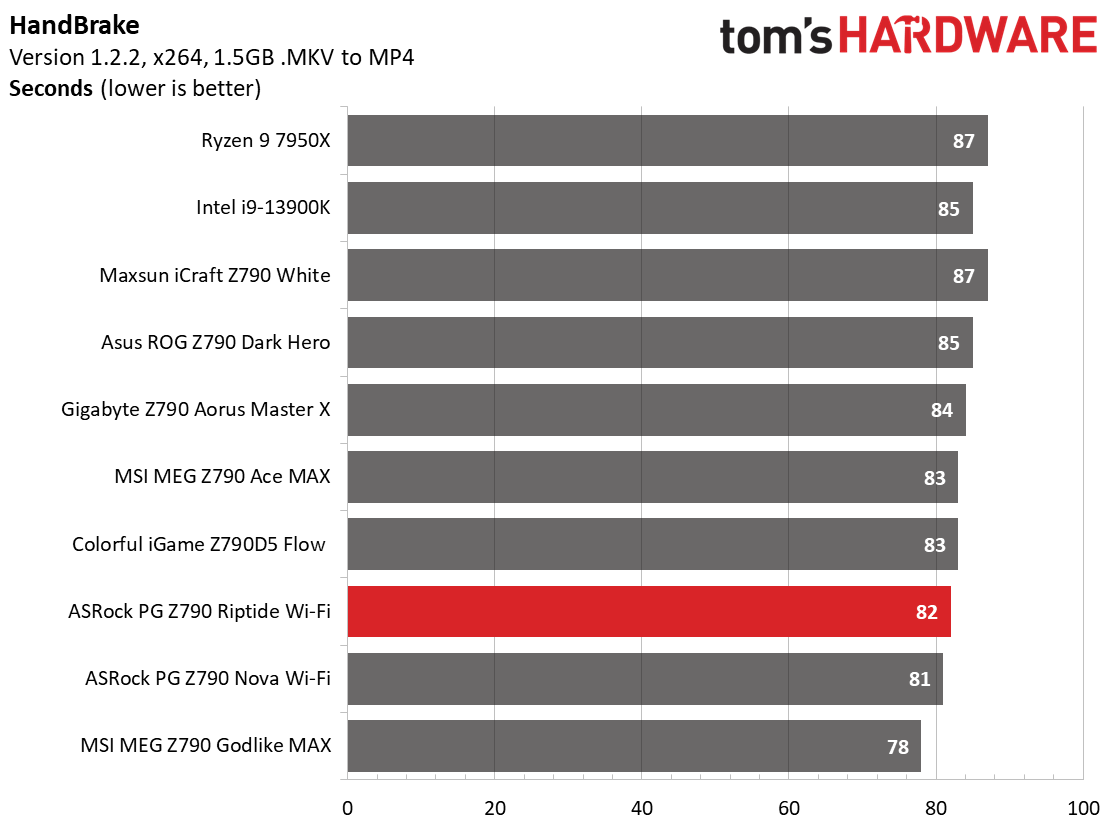
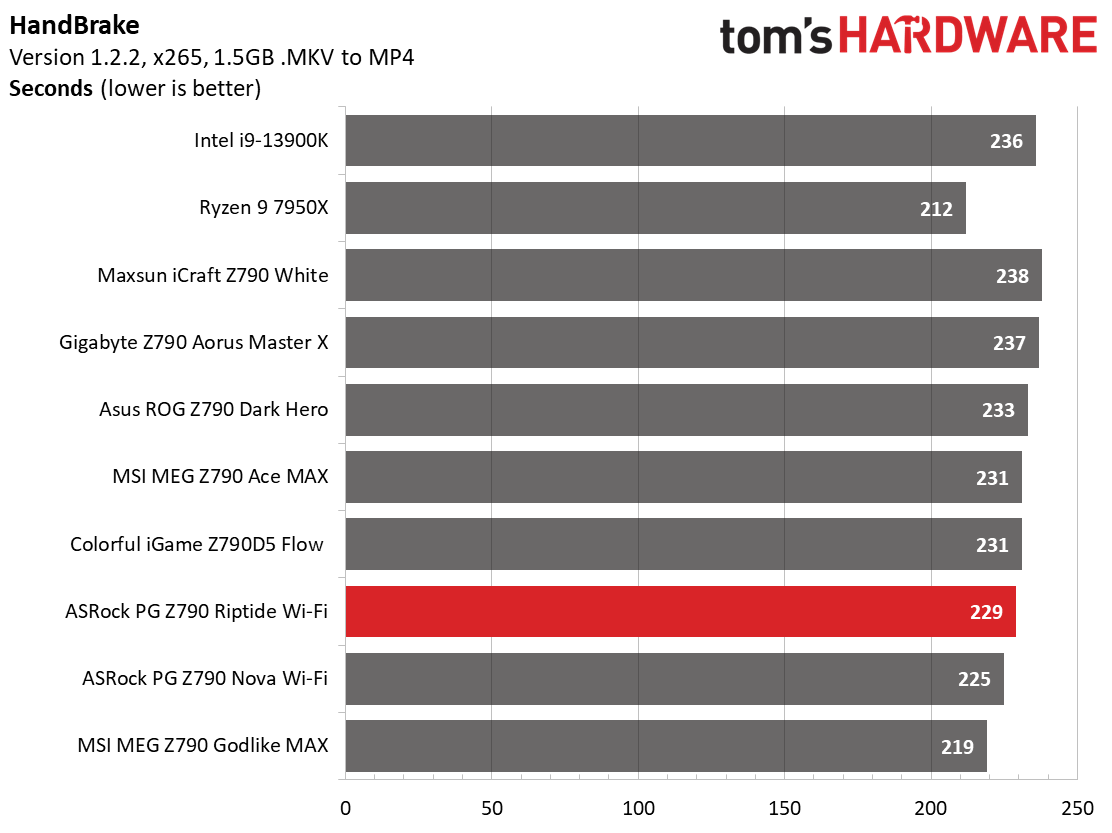
In our timed applications, the Z790 Riptide was average in Corona and LAME and slightly faster than in Handbrake. There’s nothing to worry about here.
3D Games and 3DMark
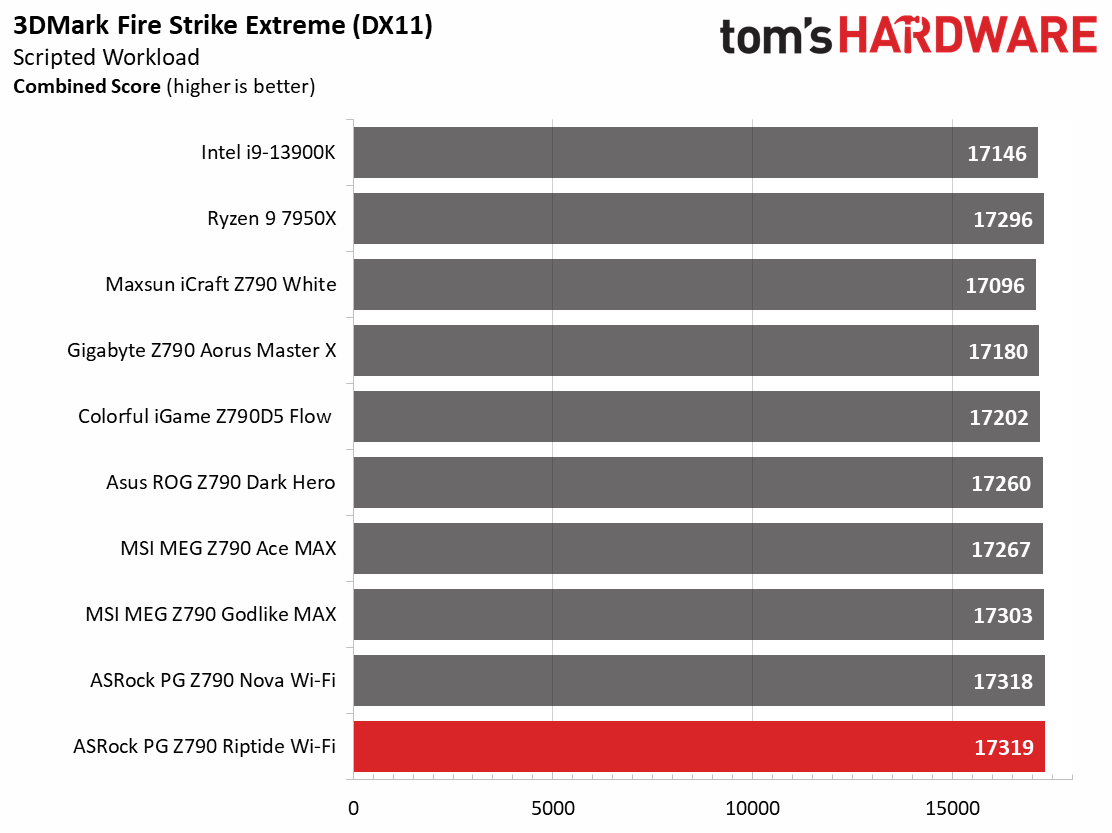
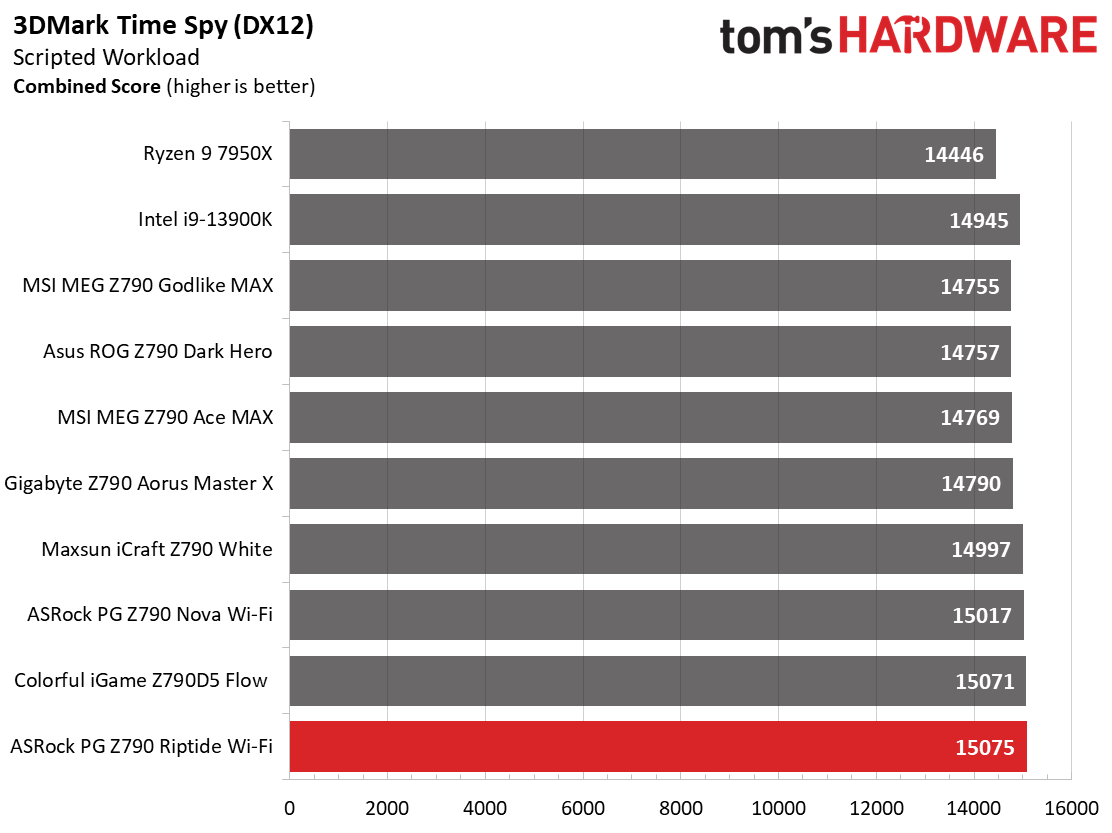
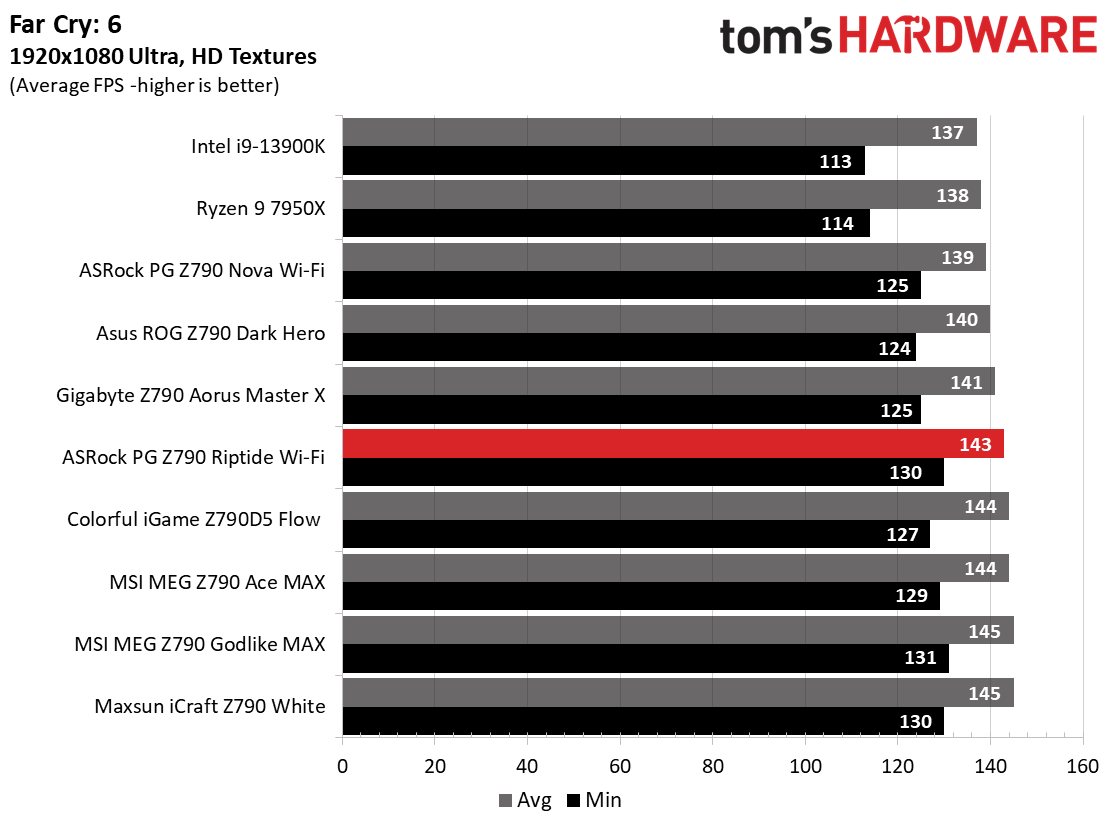
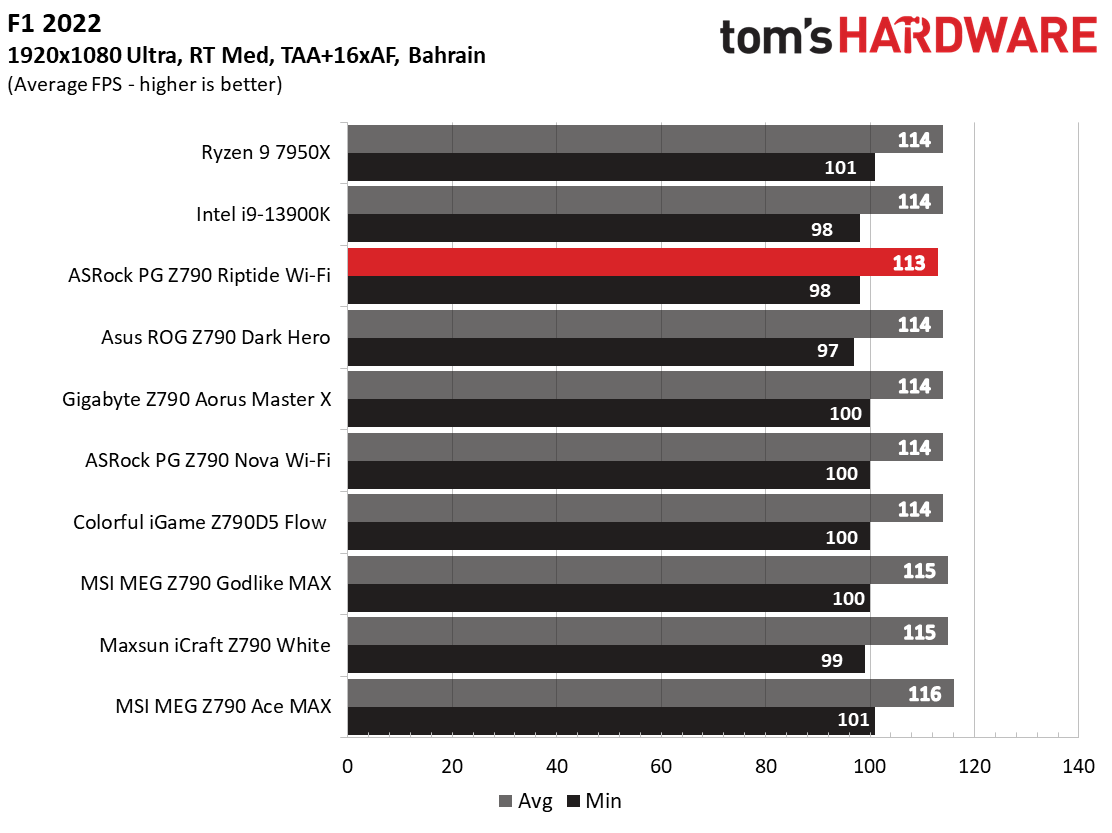
Starting with the launch of Zen 4, we shifted our test games from F1 21 to F1 22 while keeping Far Cry 6. We run the games at 1920x1080 resolution using the Ultra preset (details listed above). As the resolution goes up, the CPU tends to have less impact. The goal with these settings is to determine if there are differences in performance at the most commonly used (and CPU/system bound) resolution with settings most people use or strive for (Ultra). We expect the difference between boards in these tests to be minor, with most falling within the margin of error differences. We’ve also added a minimum FPS value, which can affect your gameplay and immersion experience.
In games, it was a tale of two tests. In the 3DMark portion, our Z790 Riptide was the highest scoring out of our tested boards albeit not by much (all results are tightly packed). Game testing showed an average result in Far Cry 6, mixing in with the other results, while in F1 22, it was slower than the average by a couple of percent. Unless you have a frame counter up, you’d never notice the difference here.
Overclocking
Generation after generation, overclocking headroom has been shrinking with both Intel and AMD processors, with motherboard partners pushing the limits to set themselves apart from the plethora of options available to the consumer. With the overclocking headroom gone, we’ve left things at stock for cores but will push the Integrated Memory Controller (IMC) for faster RAM. Remember, for 14th-gen CPUs, the maximum stock spec for memory is DDR5-5600. We have a DDR5-7200 kit and a DDR5-8000 kit in-house to test the higher speeds.
Get Tom's Hardware's best news and in-depth reviews, straight to your inbox.
Using the latest BIOS when writing (5.07 from 12/29/23), we got our Teamgroup DDR5-7200 kit working (enable XMP and go). However, our Klevv DDR5-8000 kit wouldn’t play nice. This specific kit was not on ASRock;s Memory QVL list, but similar DDR5-8000 kits (from Klevv, even) were. If you’re trying to push such faster memory, make sure it’s on the QVL, AND you have a memory IMC that will reach those speeds, as not many will do over 8000 MHz.
Power Consumption / VRM Temperatures
We used AIDA64’s System Stability Test with Stress CPU, FPU, Cache, and Memory enabled for power testing, using the peak power consumption value. The wattage reading is from the wall via a Kill-A-Watt meter to capture the entire PC (minus the monitor). The only variable that changes is the motherboard; all other parts remain the same. Please note we moved to using only the stock power use/VRM temperature charts. Since the system uses every available degree Celsius, unless you’re using a sub-ambient cooling solution, you’ll use more power and generate more heat using default settings.
Power consumption on this board was also a tale of two states. At idle, the board sat around 60W, the second lowest value so far. It peaked at 428W during load testing and grouped with some of the higher results. The load results are high due to the cooler setting at the PL2 limit set at 320W.
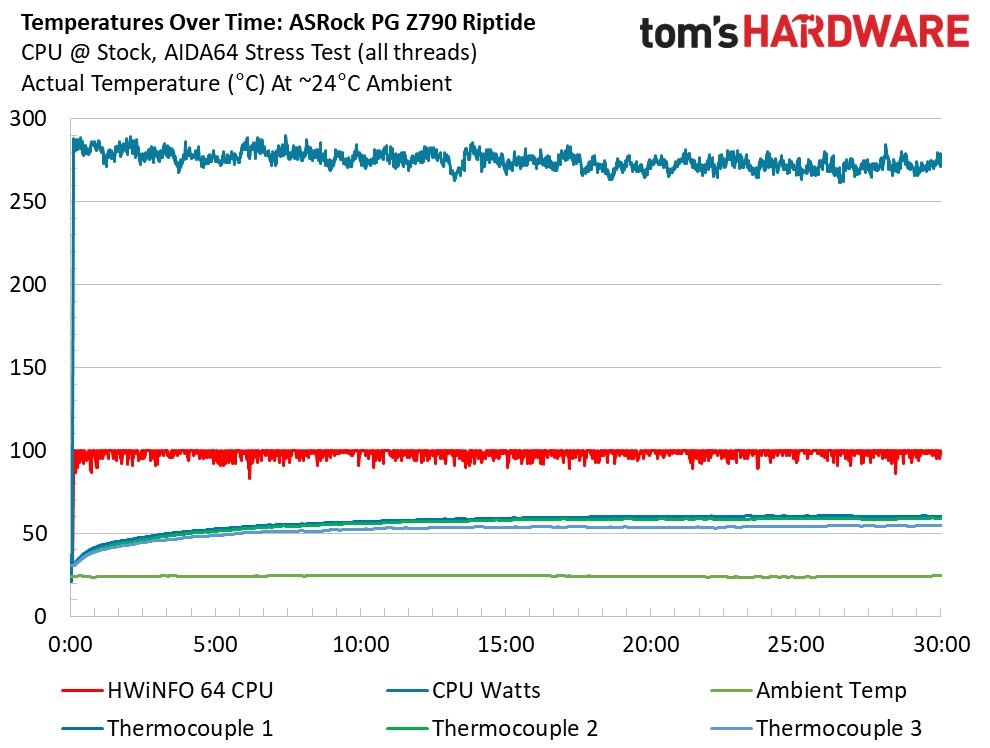
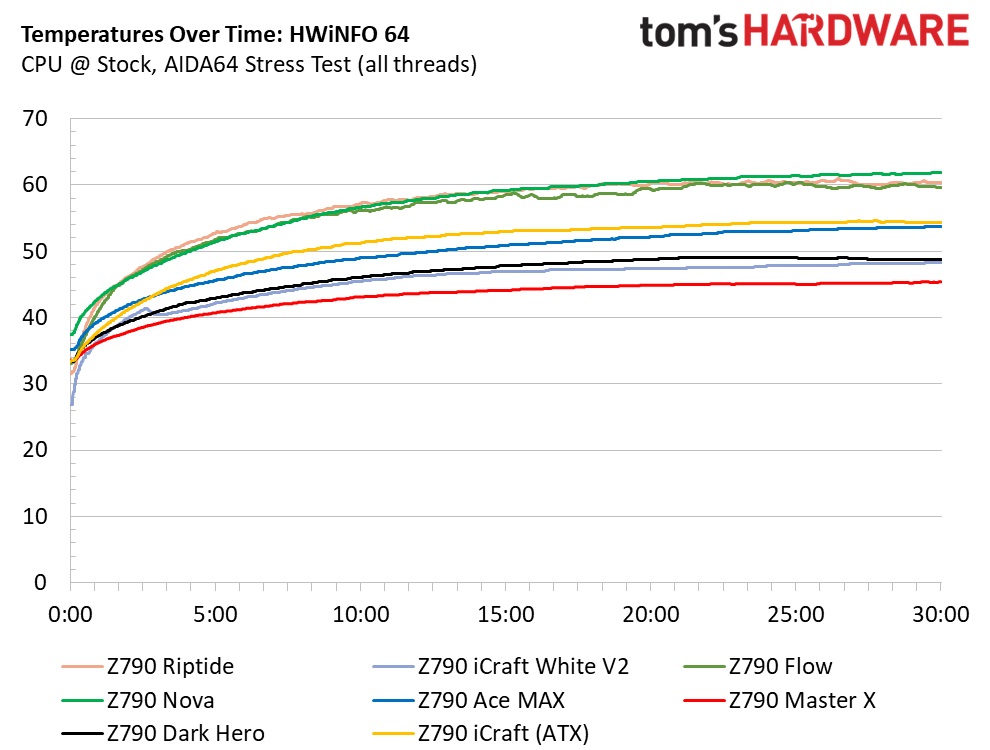
VRM temperatures peaked at just over 60 degrees Celsius, well below the SPS MOSFETs' limit. It reached these speeds because of our cooler setting that raised the PL limit. Interestingly, we never saw the full 320W during our testing due to thermal throttling. Regardless, the VRMs and the heatsinks handled our i9-14900K without flinching. You’ll even be able to overclock without worry. Just make sure to have adequate airflow inside your chassis, as you should with any system.
Bottom Line
ASRock has hit another homerun in the Z790 PG Riptide. If your build uses a lot of storage, M.2-type or SATA, it’s one of the least expensive boards with eight SATA ports and one of the cheapest with five M.2 sockets (one of those PCIe 5.0-capable). On top of that, you get capable power delivery, integrated Wi-Fi 7, and native 14th-gen processor support. The mostly black appearance and bright RGB lighting fit nicely into most chassis and build themes. You also get an eDisplayPort if you want to use an eDP-capable monitor. In short, it’s a well-rounded motherboard with few shortcomings, especially for the price. The only concerns some may run into is the generally slower USB ports on the rear IO with only two USB 3.2 Gen 2 (10 Gbps) ports where most of the competition has three and a 20 Gbps Type-C port on the rear IO (front panel for this board). Otherwise, it has everything most users are likely to expect from the Z790 platform.
Choosing the right budget-priced motherboard as you’ll want to be sure you get the most for your money. This space is shared with similar boards, including the Asus TUF Gaming Z790-Plus Wi-Fi ($249), MSI Pro Z790-A MAX Wi-Fi ($259.99), Gigabyte Z790 Aorus Elite X AX ($289.99). These boards support 14th-gen processors natively and are considered a ‘refresh’ or mid-cycle update. Only the MSI includes Wi-Fi 7, while none have PCIe 5.0-capable M.2 storage (nor five total M.2 sockets) and are also short on SATA count comparatively. While most of us don’t need Wi-Fi 7 or that amount of storage, ASRock’s board is still less expensive than the rest, while offering more from a specifications standpoint.
In the end, if you’re in the market for a budget Z790 motherboard, the Riptide is one of the best available in its price range.
MORE: Best Motherboards
MORE: How To Choose A Motherboard
MORE: All Motherboard Content
MORE: Best Motherboards
MORE: How To Choose A Motherboard
MORE: All Motherboard Content

Joe Shields is a staff writer at Tom’s Hardware. He reviews motherboards and PC components.
-
Gururu I got a little confused because there are two boards, one is WiFi and the other is not. This appears to be the Wifi Version.Reply
non-wifiwifi -
thestryker If PCIe 5.0 M.2 is going to be listed as a pro on Z790 it also needs to be in con for cutting the primary slot to x8 when in use. Like most boards it also doesn't actually add a M.2 to the board either because it's one or the other situation between M2_1 and M2_5 so it doesn't actually have 5 M.2 slots it has 4.Reply -
xyriin Recently purchased this board for my upgrade to a 14700K. The hardware is great and a better value than similar offerings.Reply
The flaw? ASRock's RGB software is hot garbage.
How bad? When the software locks up while you are changing lighting settings it corrupts the firmware. For a fix you have to flash firmware and reboot. I haven't been able to run the software longer than 5 minutes without a crash. -
Hrdwr Reply
Not really, that's mostly the case which cheaper boards where pcie 5.0 and pcie 4.0 m.2 slots overlap physically or all m.2 ports except one are connected to chipset. Here you can really use all 5 simultaneously (first 2 are connected to the cpu and other 3 to chipset) and this is cheapest such board you can find. Asrock Nova is probably only one where you can have 6. Keep in mind that having 2 or more on the chipset can bottleneck chipset connection that has only 8 DMI lanes, but using so many drives at once is rare case scenario and people needing more high speed connectivity should opt for lower tier AMD based HEDT. Nevertheless, prior to this you would need 4 m.2 slot PCIE card for this purpose that would cost you at least 100$ and be worse at cooling those drives. As there's less available 4TB nvme and 8TB are expensive and there's no use using SATA SSD at these prices many people will find use of this. As for the x8 GPU penalty it's only 5% for fastest GPUs so a none issue for most people anyway... There's always some compromising to do and all these features are fantastic storage leap compared to ones we had just few years ago....thestryker said:If PCIe 5.0 M.2 is going to be listed as a pro on Z790 it also needs to be in con for cutting the primary slot to x8 when in use. Like most boards it also doesn't actually add a M.2 to the board either because it's one or the other situation between M2_1 and M2_5 so it doesn't actually have 5 M.2 slots it has 4. -
xyriin Reply
You are correct that there are five independent M.2 slots that can be used at the same time. However, even the Asrock Nova board is limited to x8 mode on PCIE1 when the PCIe Gen5 M.2 slot is in use. Even ultra high-end boards like the Asus ROG Formula/Dark Hero that have two PCIE Gen5 PCIE slots; disable PCIE2 and degrade PCIE1 to x8 when using the PCIe Gen5 M.2 slot.Hrdwr said:Not really, that's mostly the case which cheaper boards where pcie 5.0 and pcie 4.0 m.2 slots overlap physically or all m.2 ports except one are connected to chipset. Here you can really use all 5 simultaneously (first 2 are connected to the cpu and other 3 to chipset) and this is cheapest such board you can find. Asrock Nova is probably only one where you can have 6. Keep in mind that having 2 or more on the chipset can bottleneck chipset connection that has only 8 DMI lanes, but using so many drives at once is rare case scenario and people needing more high speed connectivity should opt for lower tier AMD based HEDT. Nevertheless, prior to this you would need 4 m.2 slot PCIE card for this purpose that would cost you at least 100$ and be worse at cooling those drives. As there's less available 4TB nvme and 8TB are expensive and there's no use using SATA SSD at these prices many people will find use of this. As for the x8 GPU penalty it's only 5% for fastest GPUs so a none issue for most people anyway... There's always some compromising to do and all these features are fantastic storage leap compared to ones we had just few years ago....
In my opinion, we just aren't there yet for PCIe Gen 5 drives. Until CPUs and chipsets can support 16x16 it doesn't make a whole lot of sense and the cooling concern is still a factor. -
35below0 Reply
I agree about asking too much from a cheaper board, but the objection about downgrading the main PCIe x16 slot stands. There are practically no other features that conflict with each other or cancel each other out, or are limited and disclaimed with *** (RAM being the most obvious exception). the PCIE1 and M.2_A are kind of important and not being able to have both almost defeats the purpose of "blazing" 5.0 NVMesHrdwr said:Not really, that's mostly the case which cheaper boards where pcie 5.0 and pcie 4.0 m.2 slots overlap physically or all m.2 ports except one are connected to chipset. Here you can really use all 5 simultaneously (first 2 are connected to the cpu and other 3 to chipset) and this is cheapest such board you can find. Asrock Nova is probably only one where you can have 6. Keep in mind that having 2 or more on the chipset can bottleneck chipset connection that has only 8 DMI lanes, but using so many drives at once is rare case scenario and people needing more high speed connectivity should opt for lower tier AMD based HEDT. Nevertheless, prior to this you would need 4 m.2 slot PCIE card for this purpose that would cost you at least 100$ and be worse at cooling those drives. As there's less available 4TB nvme and 8TB are expensive and there's no use using SATA SSD at these prices many people will find use of this. As for the x8 GPU penalty it's only 5% for fastest GPUs so a none issue for most people anyway... There's always some compromising to do and all these features are fantastic storage leap compared to ones we had just few years ago....
I wouldn't so off-handedly dismiss the 8x downgrade.
On the other hand, this board costs less and offers plenty of M.2 slots. So the non-gamer and gamer can both have their cake with the same board. Just not both cakes. -
thestryker Reply
So about that in the manual it quite literally says the following:Hrdwr said:Not really, that's mostly the case which cheaper boards where pcie 5.0 and pcie 4.0 m.2 slots overlap physically or all m.2 ports except one are connected to chipset. Here you can really use all 5 simultaneously (first 2 are connected to the cpu and other 3 to chipset) and this is cheapest such board you can find.
Either M2_1 or M2_5 can be used at a time.
They literally occupy the same area on the motherboard with alternating socket sides. Even if it did work you're not going to stack a PCIe 4.0 and 5.0 drive.
Adding a PCIe 5.0 M.2 is not necessary for having a ton of M.2 connectivity. It's a tradeoff (until Intel adds dedicated lanes which they are) for very minimal returns to check a box. You can get the same thing by wiring up two PCIe slots to PCIe 5.0, but give your customers more flexibility in the process. Nobody should be happy with making their primary slot x8 and only being able to use x4 of the remnant.Hrdwr said:Asrock Nova is probably only one where you can have 6. Keep in mind that having 2 or more on the chipset can bottleneck chipset connection that has only 8 DMI lanes, but using so many drives at once is rare case scenario and people needing more high speed connectivity should opt for lower tier AMD based HEDT. Nevertheless, prior to this you would need 4 m.2 slot PCIE card for this purpose that would cost you at least 100$ and be worse at cooling those drives. As there's less available 4TB nvme and 8TB are expensive and there's no use using SATA SSD at these prices many people will find use of this. As for the x8 GPU penalty it's only 5% for fastest GPUs so a none issue for most people anyway... There's always some compromising to do and all these features are fantastic storage leap compared to ones we had just few years ago.... -
xyriin Reply
You may be thinking about another motherboard model. The PG Riptide has five physically discrete M.2 slots that do not overlap. You can see this on page 7 of the manual. In addition, the following warnings about the dedicated M.2 Gen 5 slot are as follows:thestryker said:So about that in the manual it quite literally says the following:
They literally occupy the same area on the motherboard with alternating socket sides. Even if it did work you're not going to stack a PCIe 4.0 and 5.0 drive.
Adding a PCIe 5.0 M.2 is not necessary for having a ton of M.2 connectivity. It's a tradeoff (until Intel adds dedicated lanes which they are) for very minimal returns to check a box. You can get the same thing by wiring up two PCIe slots to PCIe 5.0, but give your customers more flexibility in the process. Nobody should be happy with making their primary slot x8 and only being able to use x4 of the remnant.
Page 2 - If M.2_GEN5 is occupied, PCIE1 will downgrade to x8 mode.
Page 4 - If M.2_GEN5 is occupied, PCIE1 will downgrade to x8 mode.
Page 25 - If M.2_GEN5 is occupied, PCIE1 will downgrade to x8 mode.
Page 44 - If M.2_GEN5 is occupied, PCIE1 will downgrade to x8 mode.
Page 47-52 - Cover installation of M2_1-4 and no warnings related to M2_GEN5
Page 12 - You can see the lane assignments where the M2_GEN5 slot shares ONLY with PCIE1
Further, the manual never refers to any M.2 slot as M2_5; only M2_1, M2_2, M2_3, M2_4 and M2_GEN5. You are of course free to correct any errors by referencing the appropriate page number in the manual.
But going back to your original statement. Your first sentence is correct in that using M2_GEN5 will drop PCIE1 to x8. However, your second sentence is incorrect because the PG Riptide can use five M2 drives at the same time. -
thestryker Reply
Yup there are apparently two different PG Z790 Riptide boards and this review misnames the one being reviewed (WIFI is part of the name). I should have looked for the matching wifi spec, but yeah splitting the lanes off is still dumb.xyriin said:You may be thinking about another motherboard model. -
Hrdwr Reply
I stand corrected, I thought the article is about riptide wifi, not regular riptide. That one actually has 5 independent m.2 slots and all can be used at the same time, but pcie 5.0 slot still gets downgraded. It also has heatsinks for all the drives, tad better VMRs and support for up to 8000 mhz memory, but does cost more...thestryker said:So about that in the manual it quite literally says the following:
They literally occupy the same area on the motherboard with alternating socket sides. Even if it did work you're not going to stack a PCIe 4.0 and 5.0 drive.
